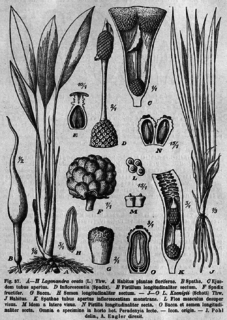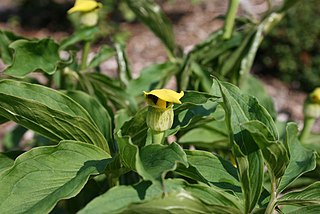
Cryptocoryne beckettii, also known as Beckett's water trumpet, is a plant species belonging to the Araceae genus Cryptocoryne.
Cryptocoryne affinis is a plant species belonging to the Araceae genus Cryptocoryne.
Cryptocoryne undulata, also known as undulate cryptocoryne, is a plant species belonging to the Araceae genus Cryptocoryne.

Cryptocoryne × willisii is a plant in the family Araceae.
Cryptocoryne aponogetifolia is a species belonging to the Araceae genus Cryptocoryne.
Cryptocoryne auriculata is a plant species belonging to the Araceae genus Cryptocoryne.

Aglaodorum is a monotypic genus of flowering plants in the family Araceae. The only species that is a member of this genus is Aglaodorum griffithii.

Aroideae is a subfamily of flowering plants in the Araceae family. It is the largest subfamily in Araceae and consists of about 72 different genera, and 2,300 species. Many Aroideae have spiny pollen grains without a sporopollenin outer exine layer and lacking an aperture.

Lagenandra is a genus of flowering plants in the family Araceae. It is endemic to the Indian Subcontinent. The genus is similar to Cryptocoryne, but can be distinguished from it by its involute vernation. Cryptocoryne on the other hand exhibit convolute vernation.

Arisaema flavum is a species of flowering plant widespread across eastern Africa and southern Asia. It is native to Ethiopia, Somalia, the Arabian Peninsula, Pakistan, Afghanistan, Nepal, Assam, Himalayas, Tibet, Yunnan, and Sichuan. The species epithet flavum is Latin for yellow and indicates its flower colour.
Hendrik (Henk) Cornelis Dirk de Wit was a Dutch systematic botanist who contributed significantly to the knowledge of the Aroid genera Cryptocoryne and Lagenandra. He grew up in the Waterland, a marshy area in the Northwest Netherlands, and had a lifelong interest in aquatic plants.

The Botanische Garten der Martin-Luther-Universität Halle-Wittenberg is an arboretum and botanical garden maintained by the University of Halle-Wittenberg. It is located at Am Kirchtor 3 in the city of Halle, Saxony-Anhalt, Germany, and open daily in the warmer months. An admission fee is charged.
Cryptocoryne dewitii is a plant species belonging to the Araceae genus Cryptocoryne. It was first described in 1977 from dried herbarium material and named in honor of the Dutch botanist Hendrik de Wit.
Cryptocoryne cruddasiana is a plant species belonging to the Araceae genus Cryptocoryne.

Cryptocoryne spiralis is a plant species belonging to the Araceae genus Cryptocoryne.
Arum hygrophilum is a species of Arum that has a disjunct distribution, found in Israel, Jordan, Lebanon, Syria, Cyprus and Morocco.
Cryptocoryne usteriana is a species of aquatic herb in the family Araceae endemic to the Philippines. It was named after the German botanist Alfred Usteri who discovered the plant in the island-province of Guimaras in 1902. The species can also be found in the mainland Panay, in tributaries of lowland bedrock river with not too rapidly flowing water and seasonal flood pools. During the summer, its natural habitat dries up and plants undergo complete meltdown. The following monsoon rain and inundation triggers the remaining rootstock or rhizome to regrow quickly and send blooms underwater. Due to overcollection for the aquarium trade, the local government categorized it as threatened species.












